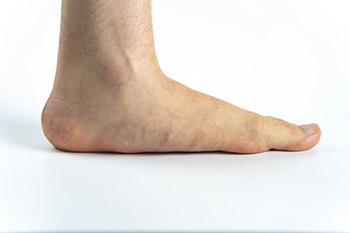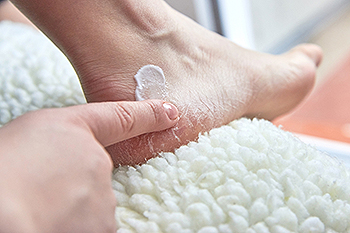Items filtered by date: January 2022
Wounds That Don't Heal Need to Be Checked
What Causes Adult-Onset Flat Feet?
It is not unusual for adults to develop flat feet as they age, even though they never had the problem before. Although this condition often affects only one foot, it sometimes occurs in both. Its main cause is changes to the posterior tibial tendon that limit its ability to lift the arch of your foot. Unfortunately, this dysfunction is progressive and usually worsens if not treated. Overuse of the tendon by walking, running, hiking or climbing stairs, is often the main cause. You may start to experience pain, swelling, a flattening of the arch and an inward rolling of your ankle. Eventually, the pain will increase, accompanied by swelling and redness. In the worst cases arthritis may develop. Several non-surgical treatments are available, including braces, orthotics, wearing a cast, and taking medication. In some cases surgery may be required. If you think you may be developing flat feet, it is suggested that you consult a podiatrist at your earliest convenience for a complete examination and to discuss appropriate treatment options.
Flatfoot is a condition many people suffer from. If you have flat feet, contact Edwin Oghoorian, DPM from Pacific Foot & Ankle Associates . Our doctor will treat your foot and ankle needs.
What Are Flat Feet?
Flatfoot is a condition in which the arch of the foot is depressed and the sole of the foot is almost completely in contact with the ground. About 20-30% of the population generally has flat feet because their arches never formed during growth.
Conditions & Problems:
Having flat feet makes it difficult to run or walk because of the stress placed on the ankles.
Alignment – The general alignment of your legs can be disrupted, because the ankles move inward which can cause major discomfort.
Knees – If you have complications with your knees, flat feet can be a contributor to arthritis in that area.
Symptoms
- Pain around the heel or arch area
- Trouble standing on the tip toe
- Swelling around the inside of the ankle
- Flat look to one or both feet
- Having your shoes feel uneven when worn
Treatment
If you are experiencing pain and stress on the foot you may weaken the posterior tibial tendon, which runs around the inside of the ankle.
If you have any questions please feel free to contact our office located in San Dimas, CA . We offer the newest diagnostic and treatment technologies for all your foot and ankle needs.
Read more about Flat FeetEverything You Wanted to Know About Ingrown Toenails
An ingrown toenail occurs when the nail grows into the surrounding skin on the sides of the nail. This condition can affect people of all ages (even babies). Ingrown toenails can be quite painful and may even become inflamed and infected. Rounding your toenails off when trimming them (rather than cutting them straight across) or cutting them too short can lead to an ingrown toenail. Wearing high heels and improperly fitted shoes that force the toes to squish together can also lead to ingrown toenails. Other possible contributing factors to ingrown toenails include injuries to the toenail, fungal toenail infections, nail deformity, and certain medications which can sometimes cause nail dystrophy. If you develop an ingrown toenail, make an appointment with a podiatrist who can treat your ingrown toenail with a variety of methods, while avoiding possible infection and preventing it from becoming ingrown again.
Ingrown toenails can become painful if they are not treated properly. For more information about ingrown toenails, contact Edwin Oghoorian, DPM of Pacific Foot & Ankle Associates . Our doctor can provide the care you need to keep you pain-free and on your feet.
Ingrown Toenails
Ingrown toenails occur when a toenail grows sideways into the bed of the nail, causing pain, swelling, and possibly infection.
Causes
- Bacterial infections
- Improper nail cutting such as cutting it too short or not straight across
- Trauma to the toe, such as stubbing, which causes the nail to grow back irregularly
- Ill-fitting shoes that bunch the toes too close together
- Genetic predisposition
Prevention
Because ingrown toenails are not something found outside of shoe-wearing cultures, going barefoot as often as possible will decrease the likeliness of developing ingrown toenails. Wearing proper fitting shoes and using proper cutting techniques will also help decrease your risk of developing ingrown toenails.
Treatment
Ingrown toenails are a very treatable foot condition. In minor cases, soaking the affected area in salt or antibacterial soaps will not only help with the ingrown nail itself, but also help prevent any infections from occurring. In more severe cases, surgery is an option. In either case, speaking to your podiatrist about this condition will help you get a better understanding of specific treatment options that are right for you.
If you have any questions please feel free to contact our office located in San Dimas, CA . We offer the newest diagnostic and treatment technologies for all your foot and ankle needs.
Read more about Ingrown ToenailsThree Steps to Smooth Feet
Dry or cracked heels are a common foot problem. Though the condition is often cosmetic, in some cases the heels can develop deep, painful cracks. To prevent this and keep your heels smooth and supple, there are three things that you can do at home. First, periodically soak your feet in warm, soapy water for 10 minutes and gently exfoliate them with a loofah or wet pumice stone. After this, dry your feet and apply moisturizer. You should moisturize your feet regularly, up to three times per day. Apply moisturizer in a circular motion to the heels and avoid putting moisturizer between your toes. Finally, wear thin cotton socks after moisturizing your feet. If home treatment does not improve your dry, cracked heels, or if they are painful, it is suggested that you see a podiatrist for treatment.
If the skin on your feet starts to crack, you may want to see a podiatrist to find treatment. If you have any concerns, contact Edwin Oghoorian, DPM from Pacific Foot & Ankle Associates . Our doctor can provide the care you need to keep you pain-free and on your feet.
Cracked Heels
It is important to moisturize your cracked heels in order to prevent pain, bleeding, and infection. The reason cracked heels form is because the skin on the foot is too dry to support the immense pressure placed on them. When the foot expands, the dry skin on the foot begins to split.
Ways to Help Heal Them
- Invest in a good foot cream
- Try Using Petroleum Jelly
- Ease up on Soaps
- Drink Plenty of Water
Ways to Prevent Cracked Heels
- Moisturize After Showering
- Skip a Shower
- Keep Shower Water Lukewarm
- Don’t Scrub Your Feet
If you are unsure how to proceed in treating cracked heels, seek guidance from a podiatrist. Your doctor will help you with any questions or information you may need.
If you have any questions, please feel free to contact our office located in San Dimas, CA . We offer the newest diagnostic and treatment technologies for all your foot care needs.
Read more about Solutions for Cracked HeelsWays to Treat Toenail Fungus
 Signs that you may have contracted a fungal toenail infection are rather easy to spot. Typically, you will notice a whitening or yellowing of the nail, and it will appear to be thicker and more brittle. The fungus, known as onychomycosis, is often spread in swimming pools, saunas, gyms, or nail salons – places where you are likely to walk barefoot. Tight socks that hold in moisture may also be a contributing factor. Heat, humidity, and perspiration help spread the infection, which is highly contagious. A few natural remedies that may help reduce the fungus from spreading include applying tea tree, lavender, lemon, or thyme oils to the affected nails. A foot bath with baking soda or white vinegar may help too. However, if the nail condition persists or spreads it is suggested that you consult with a podiatrist for an examination and treatment plan.
Signs that you may have contracted a fungal toenail infection are rather easy to spot. Typically, you will notice a whitening or yellowing of the nail, and it will appear to be thicker and more brittle. The fungus, known as onychomycosis, is often spread in swimming pools, saunas, gyms, or nail salons – places where you are likely to walk barefoot. Tight socks that hold in moisture may also be a contributing factor. Heat, humidity, and perspiration help spread the infection, which is highly contagious. A few natural remedies that may help reduce the fungus from spreading include applying tea tree, lavender, lemon, or thyme oils to the affected nails. A foot bath with baking soda or white vinegar may help too. However, if the nail condition persists or spreads it is suggested that you consult with a podiatrist for an examination and treatment plan.
If left untreated, toenail fungus may spread to other toenails, skin, or even fingernails. If you suspect you have toenail fungus it is important to seek treatment right away. For more information about treatment, contact Edwin Oghoorian, DPM of Pacific Foot & Ankle Associates . Our doctor can provide the care you need to keep you pain-free and on your feet.
Symptoms
- Warped or oddly shaped nails
- Yellowish nails
- Loose/separated nail
- Buildup of bits and pieces of nail fragments under the nail
- Brittle, broken, thickened nail
Treatment
If self-care strategies and over-the-counter medications does not help your fungus, your podiatrist may give you a prescription drug instead. Even if you find relief from your toenail fungus symptoms, you may experience a repeat infection in the future.
Prevention
In order to prevent getting toenail fungus in the future, you should always make sure to wash your feet with soap and water. After washing, it is important to dry your feet thoroughly especially in between the toes. When trimming your toenails, be sure to trim straight across instead of in a rounded shape. It is crucial not to cover up discolored nails with nail polish because that will prevent your nail from being able to “breathe”.
In some cases, surgical procedure may be needed to remove the toenail fungus. Consult with your podiatrist about the best treatment options for your case of toenail fungus.
If you have any questions, please feel free to contact our office located in San Dimas, CA . We offer the newest diagnostic and treatment technologies for all your foot care needs.
Read more about Treating Toenail Fungus




